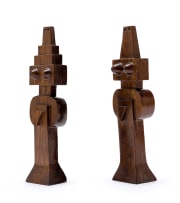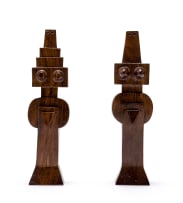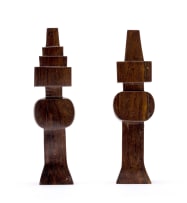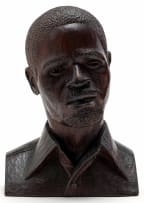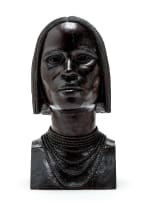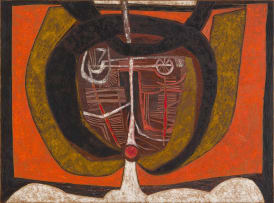Geometric Male and Female, two
Pancho Guedes
Incl. Buyer's Premium & VAT
About this Item
Notes
Architect, artist and sculptor, Pancho Guedes was born in Lisbon, Portugal in 1925, moving to Mozambique when he was 7 years old. In 1974, during the country's civil war of independence, he took up the Chair of Architecture at Wits. He had enrolled as an art student at Wits in 1945, soon changing to architecture, intimating that this discipline was the culmination and combination of various artistic trades and practices, such as harnessing the sculptural and figurative, honoring practical requirements when articulating space, and integrating traditional, local African identities in buildings. His most famous building, arguably, the Smiling Lion, is named after one of his small cement mascot figures of a smiling lion. It still stands proudly on the northern façade of the building. The mural on the western façade, designed by Guedes, is equally compelling. But it is the preliminary sketches for this building that provide the key to understanding and appreciating his sculptures. They provide the concept of the abstract nature of the mural of the top floor of the building, and, more interestingly, alternatives for the side elevation of the building, with gaping indentations to the right of each of the nine sketches, indicating the possible balconies of the six apartments of the Smiling Lion. Guedes then playfully turned these forms on their sides, which translates effortlessly into the biomorphic shapes of the pair of human figures in Lot 234. The shapes also reference the local coco de mer fruit, found on the tropical east coast of Africa and its islands, a shape favoured by none other than Walter Battiss, who used it in one of his famous screen prints. Guedes's totemic human couple, on the other hand, Lot 233, can be seen as inspired by the surrealist style and infantile themes of the artist Paul Klee, whose work Guedes not only admired, but avidly collected his whole life (his first purchase of the artist's work being as early as 1948). The graphic quality of Klee's famous Angelus Novus figure is clearly evident in Guedes's pair of wooden male and female figures.

